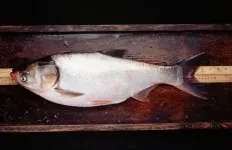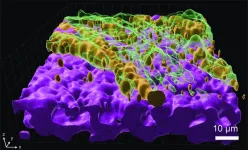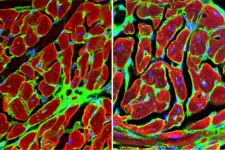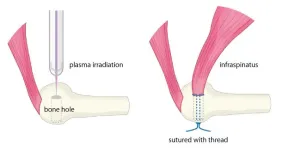(Press-News.org) Subtle temperature differences at the ocean surface allow more carbon dioxide (CO₂) to be absorbed, new research shows.
Scientists studied the “ocean skin” – a sliver less than 2 mm deep at the ocean surface that is fractionally cooler than the rest.
Theoretical and lab work have suggested this temperature difference should increase the amount of CO₂ absorbed by the ocean – but this had never been successfully observed at sea before.
The new study – led by researchers from the University of Exeter’s Penryn Campus in Cornwall – used precision measurements to confirm that the temperature of the ocean skin does indeed aid carbon absorption.
Carried out in the Atlantic, the findings suggest this ocean absorbs about 7% more CO₂ each year than previously thought. It might sound small, but when applied across all oceans this additional carbon absorption is equivalent to one and half times the carbon captured by annual forest growth in the Amazon rainforest.
The global ocean absorbs about a quarter of humanity’s carbon emissions, slowing climate change whilst also harming the ocean, and the new findings help improve our understanding of these processes.
“Our findings provide measurements that confirm our theoretical understanding about CO₂ fluxes at the ocean surface,” said lead author Dr Daniel Ford, from the University of Exeter.
“With the COP29 climate change conference taking place next month, this work highlights the importance of the oceans, but it should also help us improve the global carbon assessments that are used to guide emission reductions.”
And the team have now included this advancement within their data submission to this year’s Global Carbon Budget assessment.
The ship observations – from two European Space Agency projects – were taken by a CO₂ flux systems that measured tiny differences in CO₂ in air swirling towards the ocean surface and away again, along with high-resolution temperature measurements.
Until now, global estimates of air-sea CO₂ fluxes typically ignore the importance of temperature differences in the near-surface layer.
Dr Ian Ashton, also from the University of Exeter, said: “This work is the culmination of many years of effort from an international team of scientists. The European Space Agency’s support for science was instrumental in putting together such a high-quality measurement campaign across an entire ocean.”
Dr Gavin Tilstone, from Plymouth Marine Laboratory (PML), said: "This discovery highlights the intricacy of the ocean’s water column structure and how it can influence CO₂ draw-down from the atmosphere. Understanding these subtle mechanisms is crucial as we continue to refine our climate models and predictions. It underscores the ocean's vital role in regulating the planet's carbon cycle and climate."
The study’s international partners included sea temperature measurement experts from the European Space Agency and the university of Southampton.
It was funded by the European Space Agency, Horizon Europe and the Natural Environment Research Council.
The ship cruises were part of the Atlantic Meridional Transect (AMT) project led by PML.
The paper, published in the journal Nature Geoscience, is entitled: “Enhanced ocean CO2 uptake due to near surface temperature gradients.”
END
Sliver of cool surface water helps the ocean absorb more carbon
2024-10-25
ELSE PRESS RELEASES FROM THIS DATE:
Study: Invasive silver carp reduce movement in Chicago-area water
2024-10-25
URBANA, Ill. — Invasive silver carp have been spreading throughout the Mississippi River Basin since their introduction a half-century ago. Yet, try as they might, the fish have not advanced beyond a particular stretch of the Illinois River north of Kankakee. Research from the University of Illinois Urbana-Champaign shows the fish are likely avoiding contaminants from the Chicago Area Waterway, which flows south before petering out around Kankakee.
A new study, published today in Scientific Reports, shows silver carp change their behavior and metabolism when introduced to water from the Illinois River north of Kankakee, representing Chicago-area water.
“When animals ...
A lung pathogen’s dilemma: infect or resist antibiotics?
2024-10-25
Imagine trying to settle into a new home while constantly being attacked. That’s what the bacterium Pseudomonas aeruginosa faces when it infects the lungs, and it can’t both spread and protect itself from antibiotics at the same time. Nonetheless, it’s one of the top culprits in hospital-acquired infections and it’s notorious for causing long-lasting, antibiotic-resistant infections, causing damage especially in people with lung diseases like cystic fibrosis, COPD, or bronchiectasis.
To survive tough conditions, P. aeruginosa forms colonies ...
Batteries for miniature bio-integrated devices and robotics — here’s how to do it
2024-10-25
University of Oxford researchers have made a significant step towards realising miniature, soft batteries for use in a variety of biomedical applications, including the defibrillation and pacing of heart tissues. The work has been published today in the journal Nature Chemical Engineering.
The development of tiny smart devices, smaller than a few cubic millimeters, demands equally small power sources. For minimally invasive biomedical devices that interact with biological tissues, these power sources must be fabricated from soft materials. Ideally, these should ...
UCLA researchers uncover novel role of protein GPNMB in heart repair
2024-10-25
FINDINGS
UCLA scientists have identified the protein GPNMB as a critical regulator in the heart’s healing process after a heart attack.
Using animal models, they demonstrate that bone marrow-derived immune cells called macrophages secrete GPNMB, which binds to the receptor GPR39, promoting heart repair. These findings offer a new understanding of how the heart heals itself and could lead to new treatments aimed at improving heart function and preventing the progression to heart failure.
BACKGROUND
Every 40 seconds, ...
Political polarization poses health risks, new analysis concludes
2024-10-25
News coverage of the 2024 election season has often centered on how partisan division has affected our politics. But a new analysis shows that political polarization also poses significant health risks—by obstructing the implementation of legislation and policies aimed at keeping Americans healthy, by discouraging individual action to address health needs, such as getting a flu shot, and by boosting the spread of misinformation that can reduce trust in health professionals.
“Compared to other high-income countries, the United States has a disadvantage when it comes to the health of its citizens,” ...
Lymph node-like structures may trigger the demise of cancer tumors
2024-10-25
**EMBARGOED FOR RELEASE UNTIL OCT. 25 AT 5 A.M. ET**
A newly described stage of a lymph node-like structure seen in liver tumors after presurgical immunotherapy may be vital to successfully treating patients with hepatocellular carcinoma, according to a study by researchers from the Johns Hopkins Kimmel Cancer Center.
The study, published Oct. 25 in Nature Immunology, provides new information about lymph node-like structures called tertiary lymphoid structures. These structures, which are highly organized ...
Pitchers rejoice? Plasma irradiation might prevent tendon re-tears
2024-10-25
The human body, filled with muscles and moving parts, is far from indestructible. Injuries are common, especially where tendons and bones connect. In Japan, rotator cuff tears affect approximately 1 in 4 people over age 50, and reports state that even after surgery, about 20% of cases result in re-tears. To combat this, new healing methods to bolster current clinical practices are needed.
Graduate student Katsumasa Nakazawa, Associate Professor Hiromitsu Toyoda, and then Professor Hiroaki Nakamura at Osaka Metropolitan University’s ...
The clinical significance of microvascular inflammation after kidney transplantation
2024-10-25
San Diego, CA (October 24, 2024) — Investigators recently uncovered key insights into newly defined rejection entities in kidney transplantation that may offer improved patient risk categorization post-transplant. The research will be presented at ASN Kidney Week 2024 October 23– 27.
Kidney transplant rejection continues to threaten the long-term success of kidney transplants, with microvascular inflammation (inflammation within capillaries) playing a pivotal role in graft failure. Due to its complex nature, this inflammation poses a major challenge in clinical practice. In response, the international Banff classification—the ...
The Lancet Public Health: New Commission calls for regulatory reform to tackle the health impacts of the rapid global expansion of commercial gambling
2024-10-24
**Embargo: 23.30 [UK time] / 06.30pm [US ET] Thursday 24th October 2024**
Peer reviewed / Literature review, systematic review and meta-analysis, opinion / People
Embargoed access to the Commission report and contact details for authors are available in Notes to Editors at the end of the release.
The Lancet Public Health: New Commission calls for regulatory reform to tackle the health impacts of the rapid global expansion of commercial gambling
Gambling harms are far more substantial than previously understood, exacerbated by rapid global expansion ...
Scientists create cancer patients’ ‘digital twins’ to predict how well treatments may work
2024-10-24
Barcelona, Spain: Researchers have shown that they can accurately re-create clinical trials of new treatments using ‘digital twins’ of real cancer patients. The technology, called FarrSight®-Twin, which is based on algorithms used by astrophysicists to discover black holes, will be presented today (Friday) at the 36th EORTC-NCI-AACR [1] Symposium on Molecular Targets and Cancer Therapeutics in Barcelona, Spain.
The researchers say that this approach could be used by cancer ...






